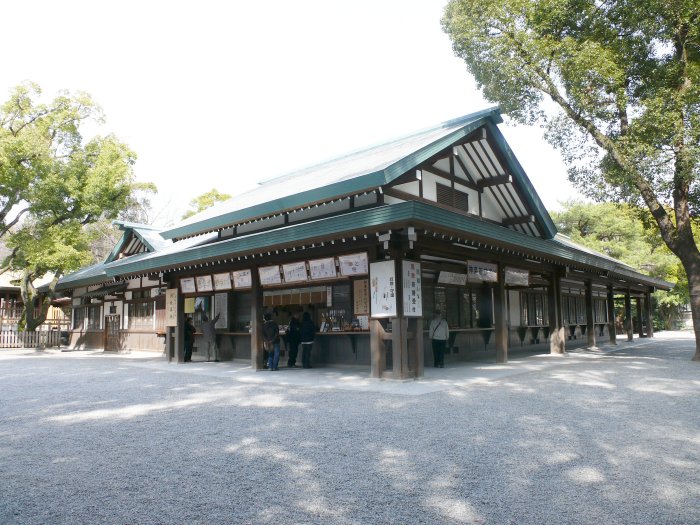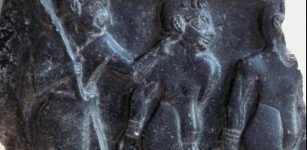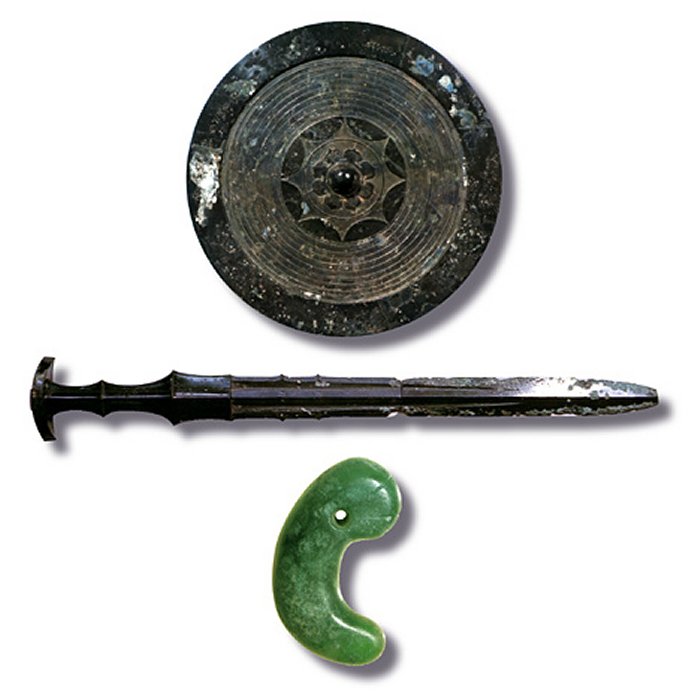Mystery Of The Kusanagi Treasure: The Legendary Sword
Ellen Lloyd - AncientPages.com - Whether the mysterious Kusanagi treasure exists or not remains unknown.
The precious Japanese treasure is allegedly kept in safety at Atsuta Shrine in Nagoya, but since the Shinto priests refuse to show the legendary sword to the public it’s very difficult to confirm the treasure’s historical references. Therefore, it is fair to say that the Kusanagi treasure remains shrouded in a veil of mystery and secrecy.
Legend Of The Kusanagi Sword
According to Japanese mythology, the Kusanagi is a magical sword that the sun goddess gave to her grandson Ninigi when he descended to earth to become ruler of Japan, thus establishing the divine link between the imperial house and the sun. The sword, along with the mirror and jeweled necklace, still forms one of the three Imperial Treasures of Japan. The Imperial Family is identified with three sacred objects such as the mirror, sword and curved jewel.
One day, the storm god Susanoo discovered the Kusanagi in the body of the eight-headed dragon (which he killed) and gave the sword to his sister Amaterasu to settle an old grievance.
Generations later, in the reign of the Twelfth Emperor, Keikō, Ame-no-Murakumo-no-Tsurugi the magical sword was given to the great warrior, Yamato Takeru.
Yamato Takeru used the sword to escape a hunting expedition and he soon became aware of the sword’s remarkable powers. He noticed that the Kusanagi gave him control of the wind and caused it to move in the direction of his swing. Taking advantage of this magic, Yamato Takeru used his other gift, fire strikers, to enlarge the fire in the direction of his enemies, and he used the winds controlled by the sword to sweep the blaze toward them.
Historical Accounts Of The Kusanagi
The first mention of the Kusanagi appears in the Kojiki, a book featuring several Japanese myths. However, the Kojiki is not considered to be a historical document. The first reliable historical mention of the sword is in the Nihonshoki that features Japanese myths and historical events that took place in ancient Japan.
In the Nihonshoki, the Kusanagi was removed from the Imperial palace in 688 and moved to Atsuta Shrine after the sword was blamed for causing Emperor Temmu to fall ill.
Is The Legendary Kusanagi Kept At The Atsuta Shrine?
The Atsuta Shrine has been one of the greatest centers of worship in Japan from ancient times. It was originally founded about 1900 years ago, when the sacred sword Kusanagi -no-tsurugi, one of the Imperial symbols, was enshrined. Atsuta was chosen as the site for the shrine by Miyasuhime-no-Mikoto, daughter of Owari-no-kuni-no-miyatsuko and wife of the then Prince Yamatotakeru-no-Mikoto, who had died leaving the sword in Hikami.

Atsuta Shrine in Nagoya dates back to c. 100 CE during the reign of Emperor Keikō and houses the Kusanagi sword. Image credit: Wikipedia
The Atsuta Shrine ranks second only to the Great Shrine of Ise.
Although the Kusanagi is allegedly kept at Atsuta Shrine, it is not available for public display, and its existence cannot be confirmed.
Shinto priest Matsuoka Masanao banished after seeing the legendary Kusanagi sword
During the Edo period, at repairing in Atsuta Shrine, the Shinto priest Matsuoka Masanao claimed to have seen the sword. According to him, "A stone box was in the wooden box of length 150 cm, red earth had been stuffed into a gap, a cored camphor tree log like a box shape was seen in the stone box, and gold was laid out, the sword was placed on it. Red earth was also stuffed between the stone box and the camphor tree box. The sword was about 84 cm long, shaped like calamus, the middle of the sword had a thickness and from the grip, about 18cm is like a fish spine, fashioned in white metallic color, and well maintained."
After witnessing, a grand priest was banished and the other priests died from a strange disease.
Does the legendary Kusanagi treasure exist? Why is the public not allowed to see the priceless sword? Many questions remain unanswered and maybe in time, we will finally learn the truth about the magical Kusanagi sword.
Written by Ellen Lloyd – AncientPages.com
Copyright © AncientPages.com All rights reserved. This material may not be published, broadcast, rewritten or redistributed in whole or part without the express written permission of AncientPages.com
Expand for referencesMore From Ancient Pages
-
 Ancient Manuscripts Of Mythical City Of Timbuktu
Artifacts | Jun 12, 2014
Ancient Manuscripts Of Mythical City Of Timbuktu
Artifacts | Jun 12, 2014 -
 Unique Miniature Roman Gold Lock Smaller Than A One-Euro Coin Discovered In Germany
Archaeology | Jan 31, 2025
Unique Miniature Roman Gold Lock Smaller Than A One-Euro Coin Discovered In Germany
Archaeology | Jan 31, 2025 -
 Maximilien de Robespierre: A True Revolutionary Man Or A Madman?
Featured Stories | Dec 22, 2015
Maximilien de Robespierre: A True Revolutionary Man Or A Madman?
Featured Stories | Dec 22, 2015 -
 On This Day In History: Johannes Kepler ‘Father Of Modern Astronomy’ Was Born – On Dec 27, 1571
News | Dec 27, 2016
On This Day In History: Johannes Kepler ‘Father Of Modern Astronomy’ Was Born – On Dec 27, 1571
News | Dec 27, 2016 -
 Who Is Buried In The Extremely Well-Preserved 2,600-Year-Old Celtic Chamber Tomb Found Near Riedlingen, Germany?
Archaeology | Oct 24, 2024
Who Is Buried In The Extremely Well-Preserved 2,600-Year-Old Celtic Chamber Tomb Found Near Riedlingen, Germany?
Archaeology | Oct 24, 2024 -
 Rare Discovery: Remains Of An Avar Warrior And A Belt Unearthed In Vinkovci, Croatia
Archaeology | May 3, 2020
Rare Discovery: Remains Of An Avar Warrior And A Belt Unearthed In Vinkovci, Croatia
Archaeology | May 3, 2020 -
 1,000-Year-Old Paintings Unearthed In Sudan – Documented By The Polish Researcher
Archaeology | Sep 25, 2022
1,000-Year-Old Paintings Unearthed In Sudan – Documented By The Polish Researcher
Archaeology | Sep 25, 2022 -
 Sacrificial Remains From The Iron Age Unearthed Near Aarhus, Denmark
Archaeology | Oct 14, 2015
Sacrificial Remains From The Iron Age Unearthed Near Aarhus, Denmark
Archaeology | Oct 14, 2015 -
 Traces Of Advanced Beings Who Walked Earth Millions Of Years Ago: Controversial Ancient History Examined
Ancient Mysteries | Jun 20, 2018
Traces Of Advanced Beings Who Walked Earth Millions Of Years Ago: Controversial Ancient History Examined
Ancient Mysteries | Jun 20, 2018 -
 On This Day In History: Teotihuacan’s Warlord Siyaj K’ak’ Conquers Tikal – On Jan 16, 378
News | Jan 16, 2017
On This Day In History: Teotihuacan’s Warlord Siyaj K’ak’ Conquers Tikal – On Jan 16, 378
News | Jan 16, 2017 -
 First Sumerian Revolt – People Oppose The Harsh Akkadian Empire
Featured Stories | Apr 14, 2023
First Sumerian Revolt – People Oppose The Harsh Akkadian Empire
Featured Stories | Apr 14, 2023 -
 Hird – Viking Warriors And Professional Body Guards Prepared To Die For Their Leader
Featured Stories | Mar 22, 2018
Hird – Viking Warriors And Professional Body Guards Prepared To Die For Their Leader
Featured Stories | Mar 22, 2018 -
 On This Day In History: Albertus Magnus – Medieval Person Of Great Historical Importance Died – On Nov 15, 1280
News | Nov 15, 2016
On This Day In History: Albertus Magnus – Medieval Person Of Great Historical Importance Died – On Nov 15, 1280
News | Nov 15, 2016 -
 Denisovan Family Tree: New Branches Revealed In Ancient DNA
Archaeology | Apr 12, 2019
Denisovan Family Tree: New Branches Revealed In Ancient DNA
Archaeology | Apr 12, 2019 -
 Streets Of Ancient Rome Were Very Dangerous
Ancient History Facts | Feb 29, 2016
Streets Of Ancient Rome Were Very Dangerous
Ancient History Facts | Feb 29, 2016 -
 Unique And Priceless Large Roman Sculptures Found At Carlisle Cricket Club
Archaeology | May 25, 2023
Unique And Priceless Large Roman Sculptures Found At Carlisle Cricket Club
Archaeology | May 25, 2023 -
 First Americans Reached The Continent 15,000 Years Earlier Than Previously Thought – Chiquihuite Cave Reveals
Archaeology | Jul 22, 2020
First Americans Reached The Continent 15,000 Years Earlier Than Previously Thought – Chiquihuite Cave Reveals
Archaeology | Jul 22, 2020 -
![Horses in the Eurasian steppes: Already 5000 years ago, they served pastoralists as a source of milk and a means of… [more] © A. Senokosov](https://www.ancientpages.com/wp-content/uploads/2021/09/pastoraliststeppe15-307x150.jpg) Milk Enabled Massive Steppe Migration – A New Study
Archaeology | Sep 24, 2021
Milk Enabled Massive Steppe Migration – A New Study
Archaeology | Sep 24, 2021 -
 Bizarre Story Of Scottish Penkaet Castle
Featured Stories | Apr 18, 2020
Bizarre Story Of Scottish Penkaet Castle
Featured Stories | Apr 18, 2020 -
 Lost Villa Of First Roman Emperor Augustus Found At Somma Vesuviana In Southern Italy
Archaeology | Apr 19, 2024
Lost Villa Of First Roman Emperor Augustus Found At Somma Vesuviana In Southern Italy
Archaeology | Apr 19, 2024




